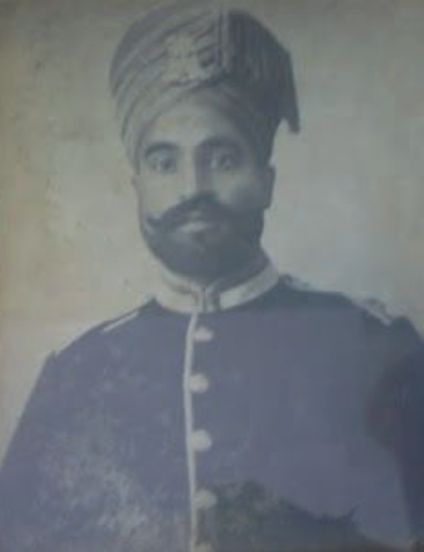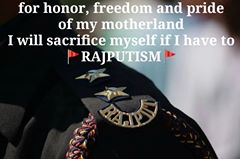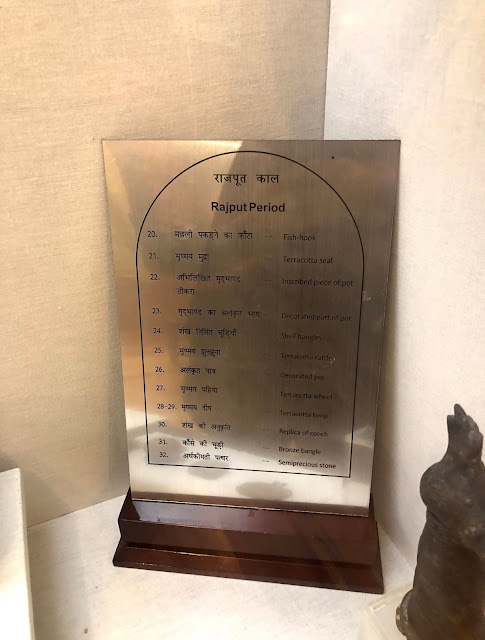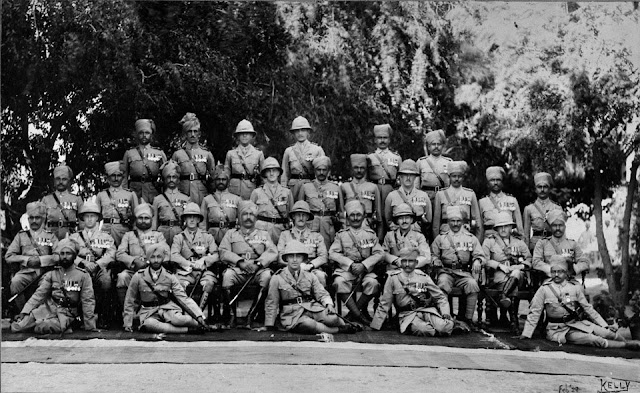2nd Queen Victoria's Own Rajput Light Infantry.
Badge.—The Royal and Imperial Cypher of Queen Victoria within the Garter.
Battle Honours.—"Delhi 1803," "Leswarree," "Deig," "Bhurtpore," "Khelat," "Afghanistan," "Maharajpore," "Punjab," "Chillianwallah," "Goojerat," "Central India," "Afghanistan 1879/80," "Burma 1885/87," "China 1900."
Uniform.—Scarlet, facings blue.
4th Prince Albert Victor's Rajputs.
Battle Honours.—"Leswarree," "Bhurtpore," "Kabul 1842," "Ferozeshah," "Sobraon," "Afghanistan 1879/80," "Burma 1885/87."
Uniform.—Scarlet, facings black.
7th Duke of Connaught's Own Rajputs.
Badge.—The Duke of Connaught's Crest and Cypher.
Battle Honours.—"Moodkee," "Ferozeshah," "Aliwal," "Sobraon," "China 1858/59," "Egypt 1882," "Tel-el-Kebir," "Pekin 1900."
Uniform.—Scarlet, facings yellow.
8th Rajputs.
Battle Honours.—"Sobraon," "Afghanistan 1879/80."
Uniform.—Scarlet, facings yellow.
13th Rajputs. (The Shekhawati Regiment.)
Battle Honours.—"Aliwal," "Afghanistan 1879/80," "Chitral."
Uniform.—Scarlet, facings blue.
16th Rajputs. (The Lucknow Regiment.)
Battle Honours.—"Lucknow" (with a Turreted Gateway), "Afghanistan 1879/80," "Burma 1885/87."
Uniform.—Scarlet, facings white. In
The Rajput Regiment is one of the oldest infantry regiments of the Indian Army tracing its origins to 1778 with the raising of the 24th Regiment of Bengal Native Infantry. The 1st battalion of the regiment was formed in 1798.
Rajput soldiers of the British Indian Army. Left to right: 13th Rajputs, man and havildar from the 7th Duke of Connaught's Own Rajputs, Subadar and servant from the 16th Rajputs, 8th Rajputs, 11th Rajputs, 2nd Queen's Own Rajput Light Infantry. Water colour by AC Lovett (1911)
When the Indian Army was reformed following the First World War, most all Rajput regiments became battalions of the one large 7th Rajput Regiment. These included the 2nd Queen Victoria's Own, 4th Prince Albert Victor's, 7th (Duke of Connaught's Own) 11th Rajputs
Indian troops(Muslim Rajputs) of 5th Light Infantry await execution in Singapore after their refusal to fight against the Ottoman Caliphate on religious grounds. Dated - March 1915, WW1
Prior to independence, the class composition of the regiment was Rajput and Punjabi Muslims (including Niazi Pathans). The regimental insignia is a pair of crossed Rajputi Katars flanked by three Ashoka leaves on either side. This is mounted by the Lion Capital of Ashoka and a scroll below with the words 'The Rajput Regiment'.
Most of the Rajput battalions saw action during the First World War. The 1st battalion fought at the Battle of Dujailah in Mesopatamia, where it was nearly annihilated. The 3rd battalion fought the Battles of Qurna and Kut-al-Amara against the Turks. In one of the battles, the Turks had invaded both the flanks of the 3rd Rajput, during which Jemadar Sital Baksh was severely wounded.
A platoon of the 1/2 Rajputs (51 Brigade, 17th Division) passing a heavy artillery battery in action at Samarra in Mesopotamia during the First World War.
Sepoy Jhandu Singh rushed to his rescue, the Jemadar ordered him to leave him behind but the sepoy lifted him on his back and started moving through the marshlands. Soon both the rescuer and the rescued became targets of the Turks and were riddled with bullets. Sepoy Jhandu Singh was awarded a posthumous Indian Order of Merit and Médaille militaire.
Subedar Major Lakshman Singh Rathore, Rajput Regiment. British-IndianArmy Dated - 1900
In 1922 the infantry regiments of the British Indian Army were reorganised and all the Rajput regiments (with the exception of 13th (Shekhawati) Rajput Infantry, which became the 10th battalion of the 6th Rajputana Rifles) were amalgamated to become battalions of the new 7th Rajput Regiment as follows:
1st battalion: from 2nd Queen Victoria's Own Rajput Light Infantry (1911–1922)
2nd battalion: from 4th Prince Albert Victor's Rajputs (1901–1922)
3rd battalion: from 7th (Duke of Connaught's Own) Rajput Infantry (1903–1922)
4th battalion: from 8th Rajput Infantry (1901–1922)
5th battalion: from 11th Rajput Infantry (1901–1922)
10th (Training) battalion: from the 16th Rajput Infantry (The Lucknow Regiment) (1901–1922)
Also the one class character of most of the infantry regiments were changed and the Rajputs introduced a company each of Punjabi Muslims and Hindustani Muslims in each of their battalions.
In late 1936 and 1937, the 3rd battalion ( 3/7 Rajput), was posted to Waziristan in what is now the tribal areas of Pakistan. During that time, they were employed against Afghan insurgents and criminal gangs raiding across the border
An infantry section of the 2nd battalion, 7th Rajput Regiment about to go on patrol on the Arakan front, 1944.
A number of Rajput battalions participated in World War 2:
The 1st battalion was in the Arakan during the Burma campaign and then took over the defence of the Andaman & Nicobar Islands.
The 2nd battalion was also in the Arakan area and a number of actions were fought by it. The capture of Point 551, also called Rajput Hill was the most important. The Japanese holding this feature had turned back repeated attacks by other battalions but the Rajputs carried the day winning an Indian Order of Merit, five Military Crosses and two Military Medals for this action.
The 3rd battalion was shipped by convoy to Egypt in August and September 1940. Their convoy was attacked several times by Italian bombers operating out of Ethiopia. The battalion's Bren guns were deployed for air defence and on one occasion are believed to have brought down an Italian aircraft. The battalion was at Suez and Egypt and was sent to defend Cyprus after the German attack on Crete as part of Indian 5th Infantry Division's 161st Indian Infantry Brigade. Here, they were mainly used in an anti-parachute role, supported by elements of Australian armour. Later, they returned to Egypt and participated in fierce fighting around Deir el Shein and Ruweisat Ridge including a particularly difficult offensive on 21/22 July 1942 where they took many casualties including the commanding officer. On 6 August, Sir Sikandar Hayat Khan, Premier of the Punjab, visited the battalion and having inspected the P.M.s of the battalion addressed them. He spoke mainly on what the Indian Army had done and was doing, and also generally on the condition in the Punjab. Later in the year the battalion participated in the Second Battle of El Alamein.
Subedar Major Ranjit Singh, 21st Native Infantry
Artist Colesworthey Grant, Year of Publication 1844
He was native of Gorakhpur and in the army of English East India Company.
The 4th battalion was also involved in the Western Desert Campaign at Sidi Barrani and El Alamein and on its return to India was posted to the Kohima front.
The 5th battalion fought in the Battle of Hong Kong. The action against the invading Japanese was short and swift with heavy casualties to the battalion. The battalion along with the British garrison was forced to surrender and the men became prisoners of war and had to undergo great hardships. 130 men of 5/7 Rajput were either beaten or starved to death or died because of a lack of medical care. The Japanese wanted Capt. Mateen Ahmed Ansari of the battalion to renounce his allegiance to the British, but he refused. For five months he was subjected to brutal beatings and treatment, as a result of which he could not walk. He was then sent to live with the other ranks instead of the officers. Capt. Ansari remained true to the regiment and organised a system for helping escapees. He was again put in jail and tortured but refused to be broken. In the end the Japanese executed him. Capt. Ansari was awarded the George Cross for his heroism.
The honours and awards tally for the Rajput Regiment is as follows:
Pre-Independence: 1 VC, 1 GC, 10 DSO, 33 MC, 10 IOM, 27 MM and 46 IDSM.
2nd Queen Victoria's Own Rajputs Light Infantry
The 200 years of history of the battalion commences with its raising at Badgaon on 30 Nov. 1798 as 1/16 Bengal Native Infantry. In the course of the next 152 years, this designation was to be altered eight times - in 1824 as 33rd Bengal Native Infantry, in 1861 as the 4th Bengal Native Infantry, in 1885 as 4th Regiment of Bengal Infantry, in 1890 as 4th (Prince Albert Victor's) Bengal Infantry,
Rajput Regiment of the Bengal Infantry, British-IndianArmy Dated - 1890
In 1897 as 4th (PAV) Rajput Regiment of Bengal Infantry, in 1921 as 2/7th Rajputs, in 1945 as 2nd Battalion The Rajput Regiment (PAV) and finally as 2nd Battalion The Rajput Regiment in 1950.
In 1803, a mere five years after its raising, the battalion fought its first battle at the pass of Leswaree ousting the French from North India. The battle honour 'Leswaree' was conferred on the unit .Thereafter, the unit participated in numerous campaigns, the battles of Kalenjra, Kalunghar, Nahun, Rampore and Gwalior being the most prominent. The seize and capture of Bharatpur Fort alongside 1 Rajput in 1825 earned the battalion its second battle honour 'Bharatpur'.
British and Indian Officers, 1st Battalion, 7th Rajput Regiment, Hyderabad, 1928.
The battalion earned its third battle honour 'Kabul 1842' operating as the vanguard of the British Expeditionary Force during the First Afghan war. During the period 1845 to 1846, the unit was again in the forefront of the First Sikh War, where it earned its fourth and fifth battle honours- 'Ferozeshah' and ' Sobraon’. The sixth battle honour -' Afghanistan 1870 - 80 ' was conferred on the unit during the second Afghan war. Thereafter, for its impressive performance in the upper Burma Campaign, the seventh battle honour' Burma 1885- 87 ' was awarded. figures of 4 officers, 7 JCOs and 270 OR killed in this action is an imprint of its valour and gallantry.
Men from 2nd Queen Victoria's Own Rajput Light Infantry in action at Flanders, Belgium during the Great War, 1914-17. These men in the pic are manning the famous Benet-Mercier machine gun during the winter of 1914–15.
The 2nd Queen Victoria's own Rajput light infantry march through Baghdad.
It was 1944 and Gorkha soldiers had been unable to crack the defences of the Japanese perched on a seemingly invincible hill in Burma (now Myanmar).
Eventually the task was handed to 2 Rajput. The Gorkha CO was sceptical. If you capture it, I’ll give you my backing, he told the Rajputs.
Backing or chindi refers to the cloth backing under the shoulder titles an officer wears on his uniform.
When 2 Rajput captured the hill, the Gorkha officer took off the black backing and handed it over.
While the rest of the Rajput Regiment wears a blue backing, this battalion has a kali chindi.
4th Prince Albert Victor's Rajputs
The battalion, which is also known as the Fighting Fourth, was raised as 1/30th Regiment of the Bengal Native Infantry in East India Company in 1815 at Danapur in Bihar. One of the oldest units of the Indian Army, 4th Battalion of The Rajput Regiment, which has the distinction of having taken part in almost every operation or war ever since its raising, In February 1845, 4 Rajput was among the units of the 7th Brigade of 3rd Division which fought in the Battle of Sobraon in Punjab in an action in which only bayonets were used. The unit earner the Battle Honour ‘Sobraon’ for its feats.
During the Second Afghan War from 1878 to 1880, the battalion helped in keeping open the Khyber Line to Kabul and fought Garra Heights in Kam Dakka area across Kabul river and won its second Battle Honour ‘Afghanistan’ in July 1881.
In the 20th century, in World War 1, 4 Rajput took part in operations in Hafiz Khor in Persia, Aden, Mesopotamia, Suez Canal, Macedonia, Tigris and North West Frontier in India securing a total of ten Battle Honours. In between the two world wars the unit was engaged in quelling Arab rebellion and saw active service in the Second World War, in Middle East and fought battles in Siddi Barani and El Alamein. A senior officer of the regiment informed that the unit also fought against the Japanese in Burma and again won ten battle honours in the Second World War.
The battalion has a large number of gallantry awards to its credit which include two Distinguished Service Orders, 14 Military Crosses, five Order of British Empire and 17 Indian Distinguished Service Medal in pre-Independence era.
7th Duke of Connaught's Own Rajputs
The 7th (Duke of Connaught's Own) Rajputs were an infantry regiment of the Bengal Army, later of the united British Indian Army. They could trace their origins to 1798, when they were the 1st Battalion, 24th Bengal Native Infantry. Over the years the regiment became known by a number of different titles. The 69th Bengal Native Infantry 1824–1828, the 47th Bengal Native Infantry 1828–1861, the 7th Bengal Native Infantry 1861–1883, the 7th (Duke of Connaught's Own) Bengal Native Infantry 1883–1893, the 7th (Duke of Connaught's Own) Rajput Regiment of Bengal Native Infantry 1893–1903 and finally after the Kitchener reforms of the Indian Army when the names of the presidencies were dropped 7th (Duke of Connaught's Own) Rajputs.
7th Rajputs, IndianArmy, Members of the 7th Rajputs British Indian Army guarding the Temple of Heaven in Beijing during the Boxer Rebellion.(Photo by Michael Nicholson/Corbis via Getty Images), Dated: 1901
During this time the regiment took part in the First Anglo-Sikh War, the Second Opium War, the Sudan Campaign, the Boxer Rebellion and World War I. After World War I the Indian government reformed the army moving from single battalion regiments to multi battalion regiments. the 7th (Duke of Connaught's Own) Rajputs now became the 3rd Battalion 7th Rajput Regiment.
Engagements:-
Moodkee
Ferozeshah
Aliwal
Sobraon
1858 - 59 China
1882 Egypt
1882 Tel-el-Kebir
1900 China
The 8th Rajputs was an infantry battalion of the British Indian Army. They could trace their origins to 1798 when they were the 1st Battalion, 30th Bengal Native Infantry. Over the years the regiment became known by a number of different titles. The 59th Bengal Native Infantry 1824–1861, the 8th Bengal Native Infantry 1861–1897, the 8th (Rajput) Bengal Infantry 1897–1901, the 8th Rajput Infantry 1901–1903 and finally the 8th Rajputs after the Kitchener reforms of the Indian Army. During this time the regiment took part in the First Afghan War, the First Sikh War and World War I. After World War I the Indian Government reformed the Indian Army again, moving from single battalion regiments to multi battalion regiments. The 8th Rajputs now became the 4th Battalion, 7th Rajput Regiment.
11th Rajputs
The 11th Rajputs was an infantry regiment of the Bengal Army and later of the British Indian Army. They could trace their origins to 1825, when they were the 2nd Extra Battalion, Bengal Native Infantry. In 1828 they were renamed the 70th Bengal Native Infantry and a number of changes in name followed the 11th Bengal Native Infantry 1861–1885, the 11th Bengal Infantry 1885–1897, the 11th (Rajput) Bengal Infantry 1897–1901, the 11th Rajput Infantry 1901–1903. Finally in 1903, after the Kitchener reforms of the Indian Army the 11th Rajputs.
During this time the regiment took part in the Second Anglo-Sikh War in the Battle of Chillianwala and the Battle of Goojerat (or Gujrat, Gujerat), the Second Opium War in China, the Third Afghan War, the Third Anglo-Burmese War and World War I. During World War I the regiment was first assigned to the Presidency Brigade, 8th Lucknow Division on internal security duties. They then served in the 33rd Indian Brigade, 12th Indian Division during the Mesopotamia Campaign.
After World War I the Indian government reformed the army again moving from single battalion regiments to multi battalion regiments. The 11th Rajputs now became the 5th Battalion, 7th Rajput Regiment.
Indian gunners manning a 9.2 inch naval artillery gun at Mount Davis Battery on Hong Kong Island.
The 5th Battalion fought in the Battle of Hong Kong, which was the most gruesome of all the battles fought by the Regiment in the war.
16th Rajputs ( The Lucknow Regiment )

The famous Bailey Guard Paltan was formed in Cawnpore in 1857 from the loyal Brahmins and Rajputs of the 13th, and the Sikhs of the 48th and 71st Bengal Native Infantry. The badge of the 16th is the turreted gateway surmounted by the number 16. This represents the Bailey Gate in the Lucknow Residency, better known in the regiment as Aitken's Post after the officer of that name who commanded the 13th.
The reformed regiment was designated The Regiment of Lucknow and received the number 16 in 1861. Since then, they have taken part in five major campaigns:
Duffla Hill Expedition - 1874-75
Afghanistan - 1880
Upper and Lower Burma - 1886 and 1887
Malakand - 1897
Campaign against the Bunerwals - 1898
In 1900 the regiment was based at Agra and the majority of recruits were drawn from farming Rajputs of the Bundelkhund district. It was a class regiment, by which is meant that all the Indians in the regiment, all eight companies, were of the same ethnic group or type ie. Rajputs. In 1914 they were based at Fort William. Their WW1 service was in India and Persia.
In 1922 they became the 10th or training battalion of the 7th Rajput Regiment based at Fatehgarh.

Subedar Hari Singh of 16th Rajputs (Lucknow Regiment )...He was the defender of Afifabad in Middle East during ww1 which he held against a determined attack in June 1918. He is photographed standing against one of the towers of the village.


























































No comments:
Post a Comment